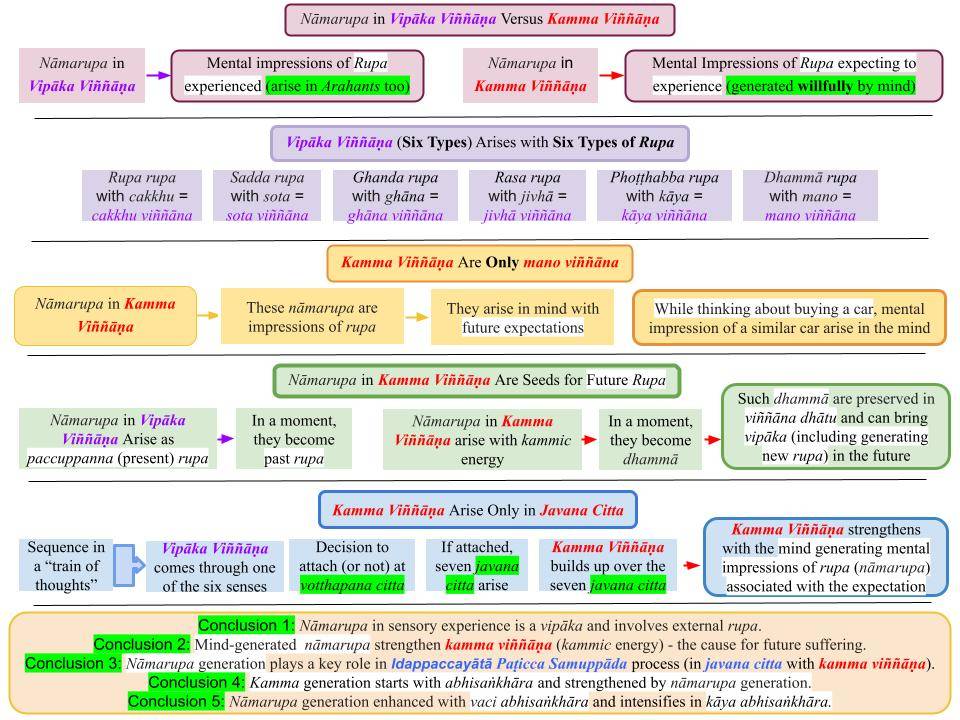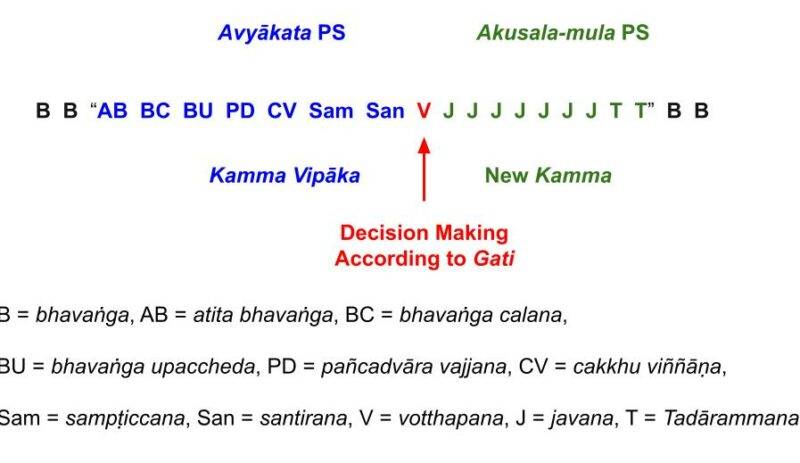“Nāmarupa” associated with Idappaccayātā Paṭicca Samuppāda are “mental impressions of rupa” created by the mind in javana citta with avijjā, abhisaṅkhāra, and kamma viññāṇa.
April 16, 2023; Chart revised April 20, 2023

Download/Print: “10. Nāmarupa in Vipāka Versus Kamma Viññāṇa“
One Type of Nāmarupa Arise in a Sensory Event (i.e., in Vipāka Viññāṇa)
1. When we see a figure, we can immediately identify that person as John, Jane, etc. Here, “nāma” and “rupa” in “nāmarupa” consists of the name of the person and their physical body.
- These are vipāka viññāṇa, and they come through the six senses as sensory inputs (ārammaṇa): eyes, ears, nose, tongue, body, and mind. Thus, a vipāka viññāṇa can be cakkhu, sota, ghāna, jivhā, kāya, or mano viññāṇa.
- In another example, when we hear a song, we can assign a “name (nāma)” to the song (if we have heard it before); the sound itself is the “sadda rupa.”
- We discussed this type of nāmarupa in the previous post, “Nāmarupa in Vipāka Viññāṇa.”
A Different Type of Nāmarupa Arise in Our Response to a Vipāka Viññāṇa
2. The response to a sensory input arises in mind only as mano viññāṇa.
- If the mind attaches to that sensory input (ārammaṇa) via greed, anger, or ignorance, then the mind establishes an expectation for future action with kamma viññāṇa (which arises in mind as mano viññāṇa.)
- With that expectation, kamma accumulation starts with a Paṭicca Samuppāda (PS) process that describes “bhava” and “jāti” within a lifetime. It is Idappaccayātā PS. I have discussed it in Refs. 1 and 2.
- Let us briefly discuss a different type of nāmarupa that arise in that Idappaccayātā PS.
Example of Nāmarupa In Idappaccayātā Paṭicca Samuppāda
3. Suppose you need to buy a car and see an appealing car parked on the street. You may instinctively say to yourself, “This is the car I like to buy, but not this color.” Then an impression of that car — in the color you like — arises in your mind. That “mental impression of the desired car” is a nāmarupa created in your mind in your javana citta! Such nāmarupa are also associated with vaci abhisaṅkhāra.
- Even though you may have had a vague idea of buying a car, now you have established a kamma viññāṇa (an expectation) of buying a particular car. Every time you see a car similar to the one you have in mind, you think a bit more about buying the car with more abhisaṅkhāra and kamma viññāṇa arising in your mind.
- Even though you may not realize it, there is a kammic energy created in each of the javana cittās associated with such kamma viññāṇa.
- That energy will stay in viññāṇa dhātu as an expectation (Ref. 3) until you either buy that car or give up that expectation if you realize that you don’t have enough money to buy it.
4. Some expectations give rise to intense “kammic energies,” and others may not have any residual effect to bring vipaka at later times. Even Arahants generate expectations for daily activities, but those only get those “tasks done.” No kammic energies are created with such actions.
- On the other hand, expectations that arise with lobha, dosa, and moha (or mundane versions of alobha, adosa, and amoha) generate kammic energies that remain in viññāṇa dhātu and can bring vipaka in the future (Ref. 3.)
- Those kammic energies are referred to as “kamma bija” or “dhammā,” depending on the context (Ref. 4.)
Kammic Energy Accumulation Happens with Kamma Viññāṇa
5. Kammic energy accumulation occurs ONLY in javana cittās with lobha, dosa, and moha (or mundane versions of alobha, adosa, and amoha), as mentioned in #4 above.
- The worst defilements of lobha, dosa, and moha COULD arise if one has not even begun to grasp the Four Noble Truths/Paṭicca Samuppāda/Tilakkhana. Then, if the sensory input is strong enough (e.g., a hefty bribe), one could engage in highly immoral deeds that will generate potent kammic energy to “power up” existence in an apāya. The “javana power” involved in such cittās is very high. In many such heinous crimes (killing, for example), energy from that javana power can also make visible changes to one’s body. The face becomes dark and brutal to look at, and the body may start shaking.
- On the other hand, javana power in mundane versions of alobha, adosa, and amoha can lead to a pleasant face, and one’s demeanor becomes calm. Such kammic energies lead to rebirths in the “good realms” with much less suffering. In the highest Deva realms, for example, there is hardly any suffering during life. However, if one had not attained at least the Sotapanna Anugāmi stage, one would have all four types of anusaya left, and thus future rebirths in apāyās remain a possibility.
Is It “Me” Attaching to an Ārammaṇa?
6. This is a critical issue to think about. We will discuss this in more detail later; I don’t want to emphasize it here. But think about the following.
- We FEEL that a sensory experience (seeing a person, for example) happens “in one shot.” It feels as if I see person X in one look at X.
- However, the Buddha described the sensory experience of a living being (not just humans) as a mechanical process.
- “Seeing a person” happens in a series of discrete events that takes place so rapidly that we are fooled into thinking it happens in “one shot.”
- That is why the Buddha called viññāṇa a magician. See “Pheṇapiṇḍūpama Sutta (SN 22.95).”
Vipāka Viññāṇa to a Kamma Viññāṇa – Basic Process
7. I have discussed this process in Ref. 5. The following is a figure from that post. It is not necessary to fully understand the terms in the figure. I will explain them in detail in future posts.

8. The essential points are the following.
- A “citta vithi” or a “stream of cittās” with 17 cittās starts with the AB citta when a sensory input (a cakkhu viññāṇa in this case) comes to mind.
- The first seven cittās analyze and accept the sensory input. At the eighth citta (V), the mind automatically decides (without conscious thinking) how to act on that sensory input. Seven javana cittās flow ONLY IF the mind decides to “take action” with lobha, dosa, and moha (or mundane versions of alobha, adosa, and amoha.) That decision is based on one’s gati at that time.
- Understanding the sensory input and taking preliminary action may take a few seconds. Hundreds of such citta vithi may flow through the mind in a split-second. We experience only their cumulative effect, not each citta vithi.
- We become aware of our actions AFTER the mind starts to take action. That is why it is critical “to be mindful.” If we realize that we are taking an unwise action, we must immediately stop that action. “Being mindful” requires an effort, and that is what is involved in Ānāpānasati (and Satipaṭṭhāna) Bhāvanā. See Ref. 6.
Kamma Accumulation In Javana Citta with Abhisaṅkhāra and Nāmarupa Generation
9. Kamma accumulation happens throughout our lives, even moment-to-moment. Some are trivial, and others can bring future rebirths in an apāya by even an action that takes only moments. For example, we have heard about people being shot in “road rage” situations or even in arguments among family members.
- A brief description of such moment-to-moment kamma accumulation (via Idappaccayātā Paṭicca Samuppāda) is described in Ref. 1, and an extensive discussion is in Ref. 2. Both those did not have an analysis based on citta vithi. I only briefly introduced that in #7 and #8 above. Buddha Dhamma is profound, and I will take an incremental approach to introduce these more profound concepts.
- Kammic energies accumulated via numerous Idappaccayātā PS processes bring rebirths via Upapatti PS, as described in Ref. 7.
- Nāmarupa formation in both types of Paṭicca Samuppāda is described, with examples, in Ref. 8. It is a good idea to read that to understand nāmarupa formation.
- In all these situations, both abhisaṅkhāra and nāmarupa formations with kamma viññāṇa play critical roles.
It Is Dangerous to Translate the Terms in Paṭicca Samuppāda Directly
10. In the next post, we will discuss the nāmarupa formation involved in the Upapatti PS and how that leads to yet another type of nāmarupa formation to result in a “person with a physical body.”
- I have purposely tried to make this post short. It has a lot of information because it takes a lot of background material to understand fully.
- Those who have read the website for a long time (and thus have read various posts on different topics) may have a good idea.
- Learning Buddha Dhamma is a never-ending process. As you can see, I keep revising posts as I gain more understanding. The hardest part is to get hold of a fundamental concept that convinces oneself of the value of Buddha Dhamma. Then one can start building on that.
11. Many people are afraid even to look at Pāli verses. But it is necessary to get an understanding of words like “viññāṇa” and “nāmarupa” (all 11 terms in PS) and use the Pāli words with that understanding. Those words have multiple meanings depending on the context and should NEVER be translated into English, for example, as “consciousness” and “name and form.”
- For example, “avijjā paccayā saṅkhāra” in the uddesa (summary) form in the “Paṭiccasamuppāda Sutta (SN 12.1)” should NEVER be translated as “Ignorance is a condition for choices.”
- In the niddesa (utterance) in the “Vibhaṅga Sutta (SN 12.2),” saṅkhāra is a bit more explained: “Tayome, bhikkhave, saṅkhārā—kāyasaṅkhāro, vacīsaṅkhāro, cittasaṅkhāro.”
- However, even that is not enough to get the meaning in the context of Paṭicca Samuppāda. Detailed explanations (paṭiniddesa) of “avijjā paccayā saṅkhāra” are scattered in various suttas. A better, but still not comprehensive, explanation is in the “Cūḷavedalla Sutta (MN 44).” I have linked to the correct marker where the explanation of saṅkhāra (in the context of PS) starts.
- “Paṭiccasamuppāda Vibhaṅga” explains the step “avijjā paccayā saṅkhāra” as, “Tattha katame avijjā paccayā saṅkhārā? Puññābhisaṅkhāro, apuññābhisaṅkhāro, āneñjābhisaṅkhāro.”
- All the above explanations are correct and need to be understood. However, until one understands the final version of the “Paṭiccasamuppāda Vibhaṅga,” one’s understanding of “avijjā paccayā saṅkhāra” is not complete. Some people complain that I write too many posts. But all I am trying to do is to break up this vast analysis into understandable pieces. See, for example, “Mental Aggregates” for several posts on saṅkhāra and other terms.
All posts in “Buddhism – In Charts.”
References
1. “Idappaccayātā Paṭicca Samuppāda“
2. “Paṭicca Samuppāda During a Lifetime.”
3. “Six Root Causes – Loka Samudaya (Arising of Suffering) and Loka Nirodhaya (Nibbāna).”
4. “Where Are Memories Stored? – Viññāṇa Dhātu,” “Dhammā, Kamma, Saṅkhāra, Mind – Critical Connections,” “Kamma Viññāṇa – Link Between Mind and Matter” and “Viññāṇa – Two Critical Meanings.”
5. “Avyākata Paṭicca Samuppāda for Vipāka Viññāṇa.”
6. “9. Key to Ānapānasati – How to Change Habits and Character (Gati).”
7. “Akusala-Mūla Upapatti Paṭicca Samuppāda.”
8. “Viññāna Paccayā Nāmarūpa.”

